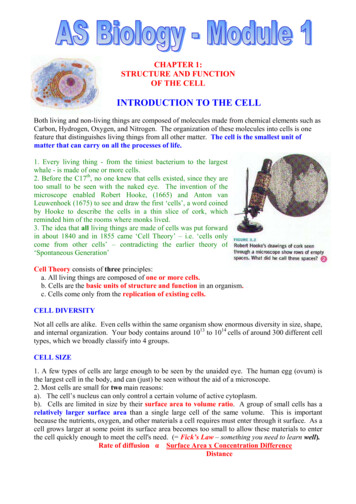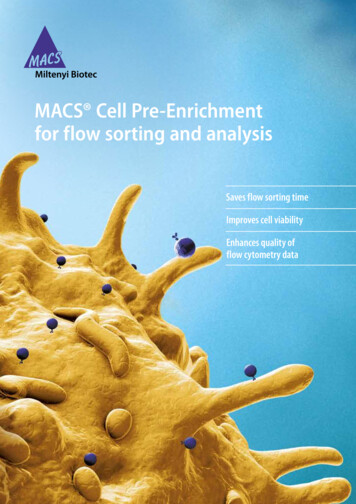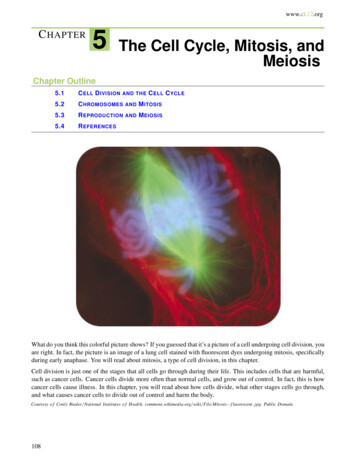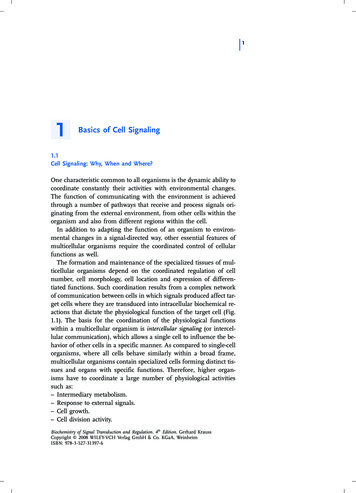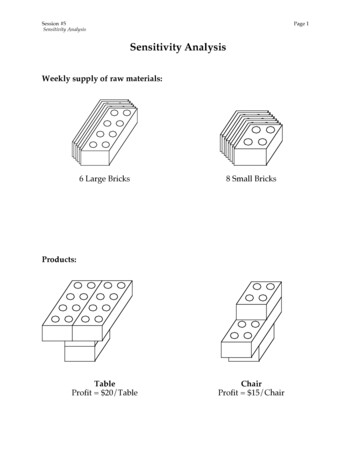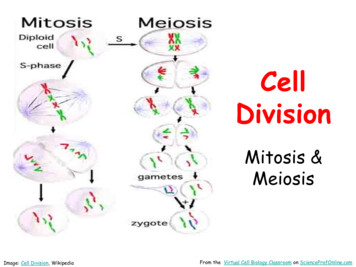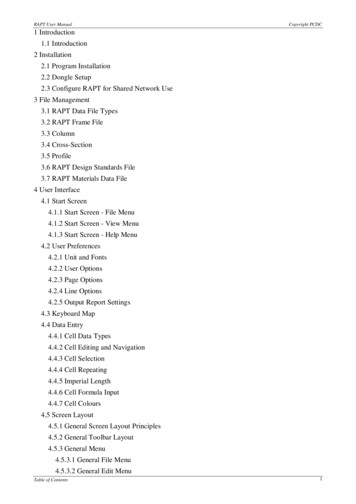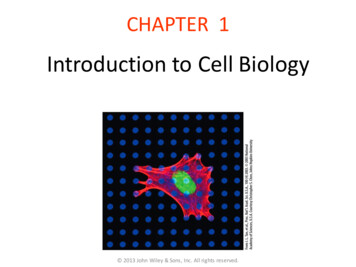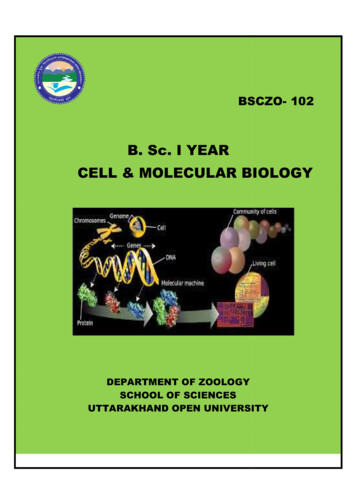
Transcription
BSCBSCZO102B. Sc. I YEARCELL & MOLECULAR BIOLOGYDEPARTMENT OF ZOOLOGYSCHOOL OF SCIENCESUTTARAKHAND OPEN UNIVERSITY
BSCZO-102Cell and Molecular BiologyDEPARTMENT OF ZOOLOGYSCHOOL OF SCIENCESUTTARAKHAND OPEN UNIVERSITYPhone No. 05946-261122, 261123Toll free No. 18001804025Fax No. 05946-264232, E. mail info@uou.ac.inhtpp://uou.ac.in
Board of Studies and Programme CoordinatorBoard of StudiesProf. H.C.S.BishtDepartment of ZoologyDSB Campus, Kumaun University,NainitalProf. B.D.JoshiRetd.Prof.Department of ZoologyGurukul Kangri, UniversityHaridwarDr.N.N.PandeySenior Scientist,Directorate of Coldwater Fisheries(ICAR)Bhimtal (Nainital).Prof. H.C.TiwariRetd. Prof. & PrincipalDepartment of Zoology,MB Govt.PG CollegeHaldwani Nainital.Dr. Shyam S.KunjwalDepartment of ZoologySchool of Sciences, Uttarakhand Open UniversityProgramme CoordinatorDr. Shyam S.KunjwalDepartment of ZoologySchool of Sciences, Uttarakhand Open UniversityHaldwani, NainitalUnit writing and EditingEditorDr.(Ms) Meenu VatsProfessor & HeadDepartment of Zoology,DAV College,Sector-10Chandigarh-160011WriterDr.Mamtesh Kumari,Associate. ProfessorDepartment of ZoologyGovt. PG CollegeUttarkashi (Uttarakhand)Dr.Sunil BhandariAsstt. Professor.Department of ZoologyBGR Campus Pauri,HNB (Central University) Garhwal.Course Title and CodeISBNCopyrightEditionPublished By: Cell and Molecular Biology (BSCZO 102): 978-93-85740-54-1: Uttarakhand Open University: 2017: Uttarakhand Open University, Haldwani, Nainital- 263139
ContentsCourse 1: Cell and Molecular BiologyCourse code: BSCZO102Credit: 3UnitBlock and Unit titlenumberBlock 1 Cell Biology or Cytology12345678Cell Type: History and origin. Prokaryotic and Eukaryotic cell. Differencebetween Prokaryotic and Eukaryotic cell.Plasma Membrane: History, Ultra structure, and chemical composition of plasmamembrane (Lamellar-models, micellar models and fluid mosaic model). Functionsof plasma membrane .Mitochondria: History and structure of mitochondria, biogenesis and functions ofmitochondria (Respiratory chain complex and Electron transport mechanism).Endoplasmic Recticulum, Ribosome, Golgi Bodies: History, structure, functionsand importance.Lysosomes, Centrioles, Microtubules: History, structure, functions andImportance.Nucleus: History, structure, functions and importance.Chromosomes: History, types and functions of chromosomes. Giantchromosomes, Polytene chromosome and Lampbrush chromosome.Cell Division: Mitosis (cell cycle stages, cytokinesis) Meiosis (reproductive cyclestages, synoptonemal complex, recombination nodules). Comparison betweenmeiosis and mitosis.BLOCK 2 Molecular 6-7980-9192-104105-128129-204129-152Structure and Type of DNA: Structure, functions and type of DNA, WatsonAnd Crick’s structural model of DNA, chemical composition of DNA, replicationof DNA and recombinant DNA.Structure of RNA: Structure of RNA (primary, secondary and tertiary structure) and153-172types of RNA (transfer RNA, messenger RNA, ribosomal RNA). Biosynthesis of mRNA, t-RNA. Function and importance of RNA.Protein Synthesis and Regulation: Protein Synthesis, mechanism (initiation,elongation and termination) of protein synthesis. Gene regulation (Operon hypothesis:regulator gene, promoter gene, operator gene, structural gene, repressor gene, corepressor gene and inducer gene), regulation at transcription, regulation by genearrangement and reversible phosphorylation, types of control mechanisms, regulation ofgene activity in eukaryotes.Genetic Code: Properties of genetic code, codons and anti codon, The WobbleHypothesis, Mutation and the triplet code.173-194195-204
ZO-102 Cell & Molecular BiologyUttarakhand Open UniversityUNIT: 1 CELL TYPEContents1.1 Objectives1.2 Introduction1.3 History and Origin1.4 Basic Components of Prokaryotic and Eukaryotic Cells1.4.1 Prokaryotic Cells1.4.2 Eukaryotic Cells1.4.3 Differences between Prokaryotic Cells and Eukaryotic Cells1.5 Summary1.6 Glossary1.7 Self Assessment Questions and Possible Answers1.7.1 Multiple Choice Questions1.7.2 Very Short Questions1.8 References and Suggested Readings1.9 Terminal and Model QuestionsPage 1
ZO-102 Cell & Molecular BiologyUttarakhand Open University1.1 ObjectivesStudy of this unit will let the students to: Define Prokaryotic cell;Explain the structure of prokaryotic cell;Write about Eukaryotic cell;Elucidate the structure of Eukaryotic cell;Differentiate between prokaryotic and eukaryotic cell.1.2 IntroductionA structure containing a mass of cytoplasm surrounded by semi-permeable membranecalled plasma membrane is called a cell. It encloses cytoplasm, many cell organellesalong with nucleus or nuclear material. On the basis of organization of membranes,variety and structure of cytoplasmic organelles and complexity of nuclear region, thecells are classified into two types: Prokaryotic cell and Eukaryotic cell. These termswere suggested by Hans Ris in 1960s.1.3 History and OriginA cell was defined as “unit of biological activity delimited by a semi permeablemembrane and capable of self-reproduction in a medium free of other living systems”by Loewy and Siekevitz (1963).The study of cell has been made possible with the help of light microscope. RobertHooke (1665) with the help of light microscope discovered that a section of cork ismade up of small cavities surrounded by firm walls. He used the term “cell” for thefirst time to describe his investigations on the “texture of a piece of cork”. Later on A.Van Leeuwenhoek (1632-1723) observed various unicellular organisms and cellslike bacteria, protozoan’s, red blood cells and sperm etc. He observed nucleus insome erythrocytes and all this was made possible with the improved microscopes. In1809, Mirble M. stated that all plant tissues are composed of cells. In the same year,importance of cells in living organisms was described by J.B. Lamarck. RobertBrown in 1831 observed nucleus in certain plant cells. Mimosa cells were boiled innitric acid by Dutrochet (1837) to separate the cells to conclude that all organictissues are composed of globular cells, united by simple adhesive forces. “All livingorganism are composed of cells” was stated by Schwann, T. (1839) after examining avariety of animals and plant tissues.Page 2
ZO-102 Cell & Molecular BiologyUttarakhand Open UniversityFig. 1.1: A Bacterial Cell1.4: BASIC COMPONENTSEUKARYOTIC CELLOFPROKARYOTICAND1.4.1 Prokaryotic CellsProkaryotic cells are the most primitive cells and have simple structural organization.It has a single membrane system. They include bacteria, viruses, blue-green algae,mycoplasmas, rickettsias, spirochetes etc. Cyanobacteria or blue green algae are thelargest and most complex prokaryote, in which photosynthesis of higher plants typehave evolved. Prokaryotes are included in the kingdom Monera and the superkingdom Prokaryota. The Prokaryotes have the following characters:1.The size of prokaryotic cells ranges between 1 to 10 µm. They occur in avariety of forms.2.Prokaryotic cell consists of three main components:(I)Outer covering: It is composed of inner cell or plasma membrane, middle cellwall and outer slimy capsule.a. Cell membrane: Cell membrane made up of lipids and proteins, is thin andflexible and controls the movement of molecules across the cell. Respiratory enzymesare carried by it for energy releasing reactions. Mesosomes, the in-folds of plasmaPage 3
ZO-102 Cell & Molecular BiologyUttarakhand Open Universitymembrane bears respiratory enzymes and these are considered analogous tomitochondria of eukaryotic cells. Similarly, the pigments and enzymes molecules thatabsorb and convert the light into chemical energy in photosynthetic cells are alsoassociated with the plasma membrane’s in-folds called photosynthetic lamella.These lamellae are analogous to the chloroplast of eukaryotic cells. Plasma membraneplays role in replication and division of nuclear material. Since the in-folds remaincontinuous with the cell membrane, they are not considered as separatecompartments. Thus, prokaryotic cell is non-compartmentalized.b. Cell wall : It is a rigid or semi-rigid non-living structure that surrounds the cellmembrane and its thickness ranges between 1.5 to 100 µm. Chemically it is composedof peptidoglycans. . Some bacteria such as mycoplasmas lack cell wall.c. Slimy capsule: A gelatinous coat outside the cell wall is the slimy capsule. It iscomposed of largely of polysaccharides and sometimes it may have polypeptides andother compounds also. It protects the cell against desiccation, virus attacks,phagocytosis and antibiotics(II) Cytoplasm: Prokaryotic cytoplasm contains proteins, lipids, glycogen andinorganic ions along with enzymes for biosynthetic reactions and ribosomes, tRNAand mRNA for protein synthesis. Prokaryotic cytoplasm has some special features asfollows:a. It lacks cell organelles like endoplasmic reticulum, mitochondria, Golgi apparatus,Centrosomes, vacuoles, Lysosomes, microfilaments, intermediate filaments andmicrotubules.b. The only cytoplasmic organelle found in prokaryotic cells is the ribosomes. Theyare smaller than eukaryotic ribosomes i.e., 70S and lie free in the cytoplasm. Theyform poly-ribosomes at the time of protein synthesis. They are the sites of proteinsynthesis.c. Like eukaryotic cells, the cytoplasm of prokaryotic cell does not show streamingmovement or cyclosis.d. Gas vacuoles are also formed in some prokaryotic cells.e. The cell does not show phagocytosis, pinocytosis and exocytose, substances enterand leave the cell through the cell membrane.f. They may contain deposits of polysaccharides or inorganic phosphates.(III) Nucleoid: Nuclear envelope is absent in prokaryotic cell and the genetic materiallies directly into the cytoplasm. Such nuclear material is known as nucleoid.Nucleoid consists of greatly coiled single pro-chromosome. It shows the followingspecial features:Page 4
ZO-102 Cell & Molecular BiologyUttarakhand Open Universitya. A short and simple pro-chromosome is present which is attached at least at onepoint on cell membrane.b. Mostly there is single copy of chromosome, the prokaryotic cell is haploid.c. The DNA is naked as it is not associated with basic histone proteins. It is doublestranded, helical and circular.d. The amount of DNA is lesser than eukaryotic cell and it codes fewer proteins.Replication of DNA is continuous throughout the cell cycle. Transcription andtranslation occurs in cytoplasm and processing of mRNA is not required.e. The processes like meiosis, gamete formation or fertilization are absent.Conjugation is seen in some bacteria.f. Mitotic apparatus absent.g. There is no nucleolus.h. Cell membrane folds or mesosomes help to segregate the replicated products ofchromosomes into daughter cells.3. Plasmids: In some prokaryotic cells, in addition to nucleoid, a small circulardouble stranded DNA molecule is present. It is called plasmid. Plasmids have 1000 to30,000 base pairs and they generally encode proteins required by the organism toresist antibiotic and other toxic material.4. Flagellum: It is a whip like locomotory structure found in many bacteria. It is150Å thick and 10 to 15µm long. As the flagellum does not have any surroundingmembrane, it grows at the tip.It has two main parts: Filament and basal body.(i)Filament- Filament extends out of cell into the medium and it is composed ofmany intertwined spiral chains of the subunits of a protein called flagellin.Flagellin differs from actins or tubulin.(ii)Basal Body- The basal body attaches the flagellum to the cell and generatesthe force to rotate it. It is composed of many components and numerous proteins. Ithas two parts: shaft and hook.5. Pili: These are short, rod like non-motile processes or fimbriae present on manybacteria. These are formed of pilin protein. They are usually less than 10 nm thick.They help in attachment of bacteria to surfaces or food or to one another. Tubular sexPili are present in some bacteria.Prokaryotic cells have all the biochemical mechanisms required to synthesizecomplex organic materials from simple organic precursors necessary for life. Thus,Page 5
ZO-102 Cell & Molecular BiologyUttarakhand Open Universityinspite of being simple in structure prokaryotes are more versatile in their syntheticactivities than eukaryotes.1.4.2 Eukaryotic CellsThe internal organization of eukaryotic cell is more developed than prokaryotic cellsfrom which they are believed to have been evolved. They are evolved to have doublemembrane system. Primary membranes are the one that surrounds the cell, celled cellor plasma membrane and the secondary membrane surround the nucleus and othercellular organelles. Eukaryotic cells occur in protists, fungi, plants and animals.Eukaryotic cells have the following characteristics:1.Number- In multicellular organisms the numbers of cells are correlated withthe body size. The human blood contains about 30 quadrillion (3 1015) corpusclesand a 60 kg human being has about 60 1015 cells. All multicellular organisms begintheir life with a single cell “Zygote” and then become multicellular by its mitoticdivision during development.2.Shape- A cell may be spherical, cuboidal, oval, disc-like, polygonal,columnar, spindle like or irregular. Thus, cells acquire a variety of shapes not only invarious organisms but also in different tissues of the same organism. The shape of cellis correlated with its functions like the shape of muscles and nerve cells are welladapted to their functions. Many factors such as cell functions, age of cell, presence orabsence of cell wall, viscosity of cytoplasm etc. are responsible for various shapes ofcells.3.Size- Most of the eukaryotic cells is microscopic and their size ranges between10 to 100µm. Sporozoits of malaria parasite (Plasmodium vivax) is among thesmallest cells having the size equal to 2µm long. While the Ostrich egg measures 175 120mm. Nerve cells are the longest having the size of its fiber to be of few meterslong. Human cells generally range from 20 to 30µm.4.Components of a cell- Three main components of the eukaryotic cells are cellmembrane, cytoplasm and nucleus. The cytoplasm and the nucleus further haveseveral components. Various cell components are discussed below:(i)Cell membrane- Cell membrane, plasma membrane or plasmalemma is a thinelastic living covering that surrounds the cell keeping the cell contents in place,provides shape to the cell and controls the transfer of materials across it. It iscomposed of lipid-protein complex. It lacks respiratory enzymes. In many protists andanimal cells it allows endocytosis and exocytosis.In certain protists, many fungi and all plant cells, the cell membrane is covered by athick, rigid non-living cell wall that protects and supports the cell. In prokaryotes thecell wall surrounding the plasma membrane has a different structure in comparison toeukaryotes.Page 6
ZO-102 Cell & Molecular BiologyUttarakhand Open University(ii)Cytoplasm- The cytoplasm or the cytosome is a semi-fluid, homogeneous,translucent ground substance known as cytoplasmic matrix or cytosol which is presentbetween the cell membrane and the nucleus. In the protozoan cell the outer firm layerof cytoplasm is called ectoplasm and the inner layer around the central fluid mass iscalled the endoplasm. The cytosol shows “cyclosis” or the streaming movement. Theeukaryotic cytoplasm has the following features:a. Organelles: The organized structures having the specific functions and capacity ofgrowth and multiplication in some cases are known as organelles. Mitochondria,centrosomes, Golgi bodies, plastids and vacuoles are the organelles that can beobserved under light microscope, while endoplasmic reticulum, ribosome,microfilaments, microtubules, intermediate filaments and micro bodies can only beseen under electron microscope. These organelles are often described as protoplasmicstructures. The cells having cilia or flagella have their basal bodies at the bases are inthe cytoplasm while rest of its part extends out of cytoplasm. These organelles aredescribed as follows:I. Mitochondria: The rod like or globule shaped structures scattered in the cytoplasmare found singly or in groups. They are bounded by double membrane oflipoproteins. The inner membrane gives out finger like structure known as cristaewhich partially subdivide the inner chamber of mitochondrion. On the inner surface ofcristae are present mushroom like structures, oxysomes that are related tophosphorylation. The space between the membranes and its lumen is filled withmitochondrial matrix. Both the membranes and the matrix contain many oxidativeenzymes and coenzymes. Since mitochondria contain DNA molecules and ribosomes,they synthesize certain proteins. They produce the energy and reserve it in the form ofadenosine triphosphate (ATP). Due to the presence of its own DNA and ability ofprotein synthesis along with its duplication, the mitochondria are called semiautonomous organelle. The DNA of mitochondria resembles that of bacterial cell;hence it is also called as endo-symbiotic organelle.II. Centrosomes: (9 0) there is a clear zone around centrioles, near the nucleus, thatincludes a specialized portion of cytoplasm, called centrospheres. Its matrix is calledkinoplasm that bears two rounded bodies the “centrioles”. Each centriole consists ofnine fibrillar units and each of them is found to contain three microtubules arrangedin a circle. Both the centrioles are arranged at right angle to each other. Centriolesform the spindles of microtubules at the time of cell division. Centrioles are absent inplant cell and the spindle is formed without their help.III.Golgi bodies: These are the stack of flattened parallel-arranged sacs andvesicles found in association of endoplasmic reticulum. They are composed of manylamellae, tubules, vesicles and vacuoles. Their membranes are supposed to beoriginated from ER and are composed of lipoproteins. In plant cells the Golgicomplex is called dictyosome that secretes required materials for the formation of cellPage 7
ZO-102 Cell & Molecular BiologyUttarakhand Open Universitywall at the time of cell division. It helps in the formation of acrosome of sperms,release of hormones, enzymes and other synthetic materials.IV.Plastids: These organelles are found in plant cells and are absent in animalcells. They may be colored like chloroplast or chromoplasts or colorless likeleucoplast. Since the leucoplast store and metabolise the starch and lipids, they arecalled amyloplast and lipoplast respectively. Chloroplast contains the green pigmentthe chlorophyll that helps in photosynthesis and protein storage. Chloroplast has adouble outer membrane, the stroma, that bears many soluble enzymes, and acomplex system of membrane bound compartments called thalakoids constitutinggranna. Like mitochondria, chloroplast also has their own DNA, ribosomes andcomplete protein synthetic machinery. Hence these are also called endo-symbiotic andsemi-autonomous organelle.V. Metaplasm: The particles like vacuoles, granules and other cytoplasmic bodiessuch as ribonucleoprotein molecules are represented by it.VI.Cilia, basal bodies and flagella: Cilia are the minute structures covering thesurface in some cells. Both cilia and flagella originate from the basal bodies orblepharoplast lying in cytoplasm. They consist of nine outer fibrils with the twolarger fibrils in the centre. Each fibril consists of two microtubules, or has 9 2arrangement. Cilia and Flagella are the structure born by certain cells. They arecomposed of microtubules made of the protein tubulin. They have 9 2 plan ofmicrotubule. Both grow at the base. They act as locomotory organelles, moves bytheir beats or undulations for they get the energy by breakdown of ATP molecule.VII. Microtubules: The ultra fine tubules of protein (tubulin) traversing thecytoplasm of plant and animal cells providing the structural framework to the cell,determine the cell shape and general organization of the cytoplasm are known asmicrotubules. Tubules are made up of 13 individual filaments. Microtubules help intransport of water and ions, cytoplasmic streaming (cyclosis) and the formation ofspindles during cell division.VIII. Basal granules: The spherical bodies found at the base of cilia and flagellaare called the basal bodies. Each of them is composed of nine fibrils and each fibrilconsists of the three microtubules, out of which two enter the cilia or flagella.IX.Ribosome’s: Ribosome is the minute spherical structures that originate innucleolus and are found attached with the membrane of endoplasmic reticulum and inthe cytoplasm. They are mainly composed of ribonucleic acids (RNA) and protein.They are mainly responsible for protein synthesis.b.Inclusions: These are the non-living or deutoplasmic structures which areincapable of growth and multiplication. Common cell inclusions are stored organicmaterials such as starch grains, glycogen granules, aleuron grains, fat droplets,pigment granules and inorganic crystals.Cytoplasm is stores raw materials needed forPage 8
ZO-102 Cell & Molecular BiologyUttarakhand Open Universitythe metabolism in both the cytoplasm and the nucleus. Many metabolic processes likebiosynthesis of fatty acids, nucleotides, proteins and oxidation take place incytoplasm. It distributes the nutrients, metabolites and enzymes in a cell and bringsabout exchange of materials between the organelles as well as with the environmentor extracellular fluid also.c.Nucleus: In a eukaryotic cell the genetic material is enclosed by a distinctnuclear envelope that forms a prominent spherical organelle the “Nucleus”. Thenuclear envelope bears pores for the exchange of materials between the cytoplasmand the nucleoplasm.Fig. 1.2: An animal cell as shown by electron microscopePage 9
ZO-102 Cell & Molecular BiologyUttarakhand Open University1.4.3 Differences between Prokaryotic Cells and Eukaryotic CellsThe internal organization of eukaryotic cell is more developed than prokaryotic cellsfrom which they are believed to have been evolved.S. No.Prokaryotic CellsS. No.Eukaryotic Cells1.A prokaryotic cell issurrounded by a singlemembrane layer.1.A eukaryotic cell issurroundedbyadoublemembranelayer.2.In most cases the cell wallsurroundstheplasmamembrane and it iscomposedofcarbohydrates,lipidsproteins and certain aminoacids.2.Cell wall is present inprotists, most fungiand plants and iscomposed of chitin inmost fungi and orcellulose in others.3.Respiratory enzymes arepresent on cell membranes.3.Absent on the cellmembrane4.Thalakoids occurs free incytoplasm.4.They occur within thechloroplast.5.Cytoplasm lacks ochondria,Golgiapparatus, microfilaments,intermediatefilaments,microtubules and microbodies. While ribosomesare present5.All the cell organellesare present in the cellalong with ribosomes.6.Gas vacuoles may occurwhile sap vacuoles areabsent.6.Sapvacuolesarecommonly present.7.70S ribosomes are presentthat lie free in cytoplasm orattached to mRNA.7.80S ribosome’s arepresent, either free orbound to ER andnuclear envelope ormRNA.Page 10
ZO-102 Cell & Molecular BiologyS. No.Uttarakhand Open UniversityProkaryotic CellsS. No.Eukaryotic Cells8.Endocytosis and exocytosedo not occur.8.These processes takeplace in many protistsand in animals.9.Process of meiosis orgamete formation or truefertilization does not occur.9.In these cells theprocess of meiosis,gamete formation andtrue fertilization occurin most cases of sexualreproduction.10.Cells are haploid.10.Cells are diploid, whilehaploid cells alsooccur.11.Nuclear envelope is absentand nuclear material lie incytoplasm and is 1.Nuclearenvelopesurrounds the nuclearmaterial. The structureis called nucleus. Itcontains two to manychromosomes.12.Nucleolus absent.12.One or more nucleoliare present within thenucleus.13.Circular DNA is presentwithoutassociatedproteins.13.Nuclear DNA is linearand is associated withproteins, while a if present aresimple, consist of a singlefibril and are formed of aprotein flagellin.14.Flagella, if present arecomplex, have 9 2pattern of microtubulesformed of a proteintubulin.15.Plasmids and pili occur inmany prokaryotic cells.15.These structures e 11
ZO-102 Cell & Molecular BiologyS. No.Prokaryotic Cellsasexual organisms.Uttarakhand Open UniversityS. No.Eukaryotic Cellssexual organisms.1.5 SUMMARYRobert Hook (1665) for the first time described the texture of a piece of cork as“cell”. Similar structures were observed by many scientists while studying manyliving organisms. It was Schwann T. (1839) who stated that all living organisms arecomposed of cells after examining a variety of plant and animal tissues. Basically twotypes of cells are there, “Prokaryotic” and “Eukaryotic”. Prokaryotic cells are theprimitive cells that include bacteria, blue-green algae, viruses and photosynthetic cellscyanobacteria etc. Their size varies from 1 to 10 um and they consist of mainly threecomponents: the outer covering that includes all cell membrane, cell wall and a slimycapsule. Another component is cytoplasm which lacks cell organelles exceptribosomes. The processes like phagocytosis and endocytosis are absent. The thirdcomponent is nucleoid that lacks nuclear membrane. Additional small circular DNAthe plasmid may also be present. Flagella and pili like structure are also seen in someprokaryotic cells. Eukaryotic cells are more developed and are surrounded by doublemembranes. Shape and size of these cells and their number in multicellular organismsvaries. It is also composed of three main components. Cell membrane or plasmamembrane is a thin elastic living covering. The cytoplasm is a semi fluid,homogenous, translucent consisting of many cell organelles, inclusions, cilia, flagella,basal bodies and microtubules.1.6 GLOSSARYCytoplasm: Gel like substance enclosed within the cell membrane excluding nucleus.Plasma membrane: It is the biological membrane that separates the interior of thecell from the outside environment.Prokaryote: The cell that lacks a distinct nucleus and other specialized membrane boundorganelles.Eukaryote: an organism whose cell contains a membrane bound distinct nucleusalong with other specialized organelles enclosed in membranes.Mesosome: The in-folding of plasma membrane in some bacterial cells that carryrespiratory enzymes.Poly-ribosome: It is a group of ribosomes associated with a single messenger RNAduring the translation process.Page 12
ZO-102 Cell & Molecular BiologyUttarakhand Open UniversityPhagocytosis: The process by which a cell engulfs a solid particle to form an internalvesicle known as phagosome is called phagocytosis, also called eating of cell.Pinocytosis: The process of intake of liquid into a cell by the budding of smallvesicles from the cell membrane is called pinocytosis, also called drinking of cell.Exocytosis: In the process of exocytosis materials are exported outside the cell byusing energy from ATP molecules.Conjugation: When the genetic material is transferred from one bacterial cell to othereither by direct contact or by a bridge like connection between two cells is calledconjugation.1.7:- Self Assessment Questions and Possible Answers1.7.1 Multiple Choice Questions:1.2.3.4.5.There is no organized nucleus in:(a)Bacterial cell (b)Green algae cell(c)Animal cellPlant cell(d)The prokaryotic cells are characterized by:(a)A distinct nuclear membrane (b)(c)Distinct chromosome (d)Absence of chromatin materialAbsence of nuclear membraneIn a prokaryotic cell, DNA is:(a)Enclosed by nuclear envelop(b)Lacking(c)Not a genetic material(d)without a membraneCell wall is found around the:(a)Prokaryotic cells(b)(c)Plant cellsAll the above(d)Algal cellsChemical energy of food stuffs is converted into biologically useful forms by:(a)Ribosomes(b)(c)Mitochondria (d)Golgi complexPlastidsPage 13
ZO-102 Cell & Molecular Biology6.by:7.8.9.10.Uttarakhand Open UniversitySun radiant energy is converted into chemical energy of organic compound(a)Mitochondria (b)Chloroplast(c)RibosomesCentrosomes(d)Which structure is present only in animal cell?(a)Cell e envelope system is characteristic of:(a)Prokaryotic cell(c)None (d)(b)Eukaryotic cellBothProkaryote and eukaryotes have the common:(a)Mitotic apparatus(b)Histone(c)Genetic code(d) MitochondriaUnicellular microscopic organisms were first studied by:(a)Robert Hooke (b)(c)Pasteur (d)PriestleyLeeuwenhoekANSWERS:1. (a)5.(c)9. (c)2. (d)6.(b)10.(d)3. (d)7.(c)4. (d)8.(a)1.7.2 Very Short Questions:1.What are prokaryotes? Give an example.2.What are eukaryotes? Give few examples.3.Cell is an open dynamic system. Is it correct?4.Prokaryotic cells are haploid. Is it so?Page 14
ZO-102 Cell & Molecular BiologyUttarakhand Open University5.What are cyanobacteria?6.Give three essential characteristics of cell?7.Where is nucleolus found?8.What are the power houses of the cell?9.Name the protein factories of prokaryotic and eukaryotic cells?10.What is the control centre of a cell?Answer:1. Organisms without an organized nucleus e.g., Bacteria2. Organisms with an organized nucleus. Plants, yeast;3. Yes4. Yes5. Blue green algae6. Cell membrane, cytoplasm, nuclear material7. Nucleus8. Mitochondria9. Ribosome10. Nucleus1.8 References and Suggested Readings:Brown, R. (1831). Observations on the organs and mode of fecundation in Orchideae andAsclepiadeae. Trans. Linn. Soc. London, 16: 685-746.Dutrochet, H. (1837). Memoires pour servir á l’ histoire anatomique et physiologique desvégétaux et des animaux. Bailliere, Paris.Hooke, R. (1665). Micrographia: or some physiological descriptions of minute bodies madeby magnifying glasses with observations and inquiries thereupon. Royal Society,London, UK.Page 15 pa
Cell and Molecular Biology DEPARTMENT OF ZOOLOGY SCHOOL OF SCIENCES UTTARAKHAND OPEN UNIVERSITY Phone No. 05946-261122, 261123 Toll free No. 18001804025 Fax
